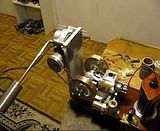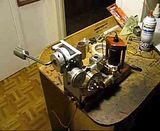Here are a couple of (from my point of view) interesting videos of the hit and miss engine under a variable load. It definitly does go in and out of hit and miss mode. However, its not CONSISTENTLY going in and out. Part of the reason for that is that my o-ring drive belt slips a bit, right at the crucial moment when the engine is supposed to be working its hardest to lift the weight. ---in fact, in one of the videos you can see my hand helping the weight "over the hump". Also, the fact that there is considerable tension in the drive belt (o-ring), means that there is some load on the engine all the time which imposes some load even when the weight is in the downswing side of its arc. The engine certainly doesn't lack for power. There are a couple of fixes for this belt slipping issue. I could go to a larger diameter pulley on the engine, which would give a larger contact area with the belt, but the slippage appears to be happening at the pulley on the gear reducer, not the engine. (All pulley systems slip a bit, its just not visible at high speeds). The better solution would be to substitute a pair of light sprockets and a roller chain for the o-ring drive and pulleys. A chain drive has a double advantage---zero slippage, and practically zero tension related drag on the engine. In the middle of one of the videos you can hear the chime that my wife rings to call me up to dinner!!! I have a two way speaker system between my office/test bench and the main floor of the house. The ratio between the engine crankshaft and the output of my worm gear reducer is about 137:1----not because I needed that much torque multiplication, but because I wanted things to happen in a slow enough time sequence that you could see and hear what was happening. As I started my preliminary testing, the first few weights I used were to puny for the engine to even notice that it was under a load. By the time I got to a load heavy enough to make the engine set up and take notice, the o-ring drive belt began to slip. I'm enjoying this, and it is very interesting.---Brian








